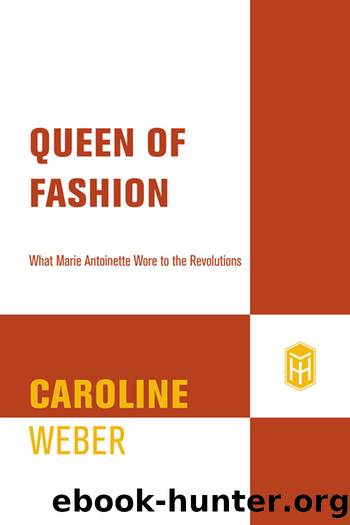Queen of Fashion by Caroline Weber

Author:Caroline Weber
Language: eng
Format: epub
Publisher: Henry Holt and Co.
Published: 2009-11-15T00:00:00+00:00
NINE
TRUE COLORS
If the people were momentarily swayed by the sight of their Queenâs tricolor garb at the Fête de la Fédération, the fact remained that her acceptance of the Revolutionâs sartorial codes in no way corresponded to an underlying conversion to its politics.1 In January 1790, she explained in a secret letter to Mercy that although as a rule she considered herself too well-born to stoop to deception, âmy current position is so unique that for everyoneâs sake, I have to change my frank and independent character and . . . [learn] how to dissimulate.â2 Her successful performance at the Fête de la Fédération was therefore just that, a performance: âOne has to participate,â she confessed to Mercy in advance of the festival, âbut oh, how I dread it.â3
Indeed, even as she sought to appease her subjectsâ wrath and diminish their hatred, she never warmed to the notion that they ought to have a hand in governing her husbandâs kingdom. Over the course of the Revolutionâs second year, she watched in horror as it took ever bolder swipes against the ancient pillars of the absolutist régime: in June 1790, the deputies of the Assemblée abolished all hereditary aristocratic titles and chivalric orders; in July, they drafted a âCivil Constitution of the Clergy,â which, in an unprecedented repositioning of the Churchâs hierarchy, deemed all clergymen servants of the state; and in December, they pushed the King to accept this Civil Constitution, very much against his will. In the face of these radical changes, Marie Antoinette came to despise the Revolution more than ever.4
Louis XVI deplored the Assembléeâs actions as well, and like his wife true colors he dreaded the moment when the deputies would finish work on Franceâs new constitution, which was bound to decree marked diminutions of his power.5 However, in his perennial indecisiveness, he seemed unable or unwilling to consider taking any forceful steps to counteract the revolutionariesâ maneuvers. Marie Antoinette, by contrast, drew daily more convinced that she and the King could not remain passive if they hoped to save their family, their position, and their kingdom from ruin.6 Her behind-the-scenes preparedness to act with courage made a strong impression on the liberal aristocrat Mirabeau, who said of her on June 20, 1790: âThere is only one man siding with the King nowâhis wife.â Then, perhaps referring to her past as an intrepid, cross-dressed equestrienne, he added: âSoon the time will come when we will have to see what a woman can do in the saddle.â7
In a satirical ditty published in a royalist newspaper at around the same time, Marie Antoinette was similarly praised for her âmasculineâ force of character, as contrasted with the sneaky feminine costume that the Duc dâAiguillon had been said to adopt when provoking the October 1789 march on Versailles:
We have been transported to a miraculous time:
While dâAiguil-- dresses up as a woman,
Antoinette becomes a courageous man.8
As Mirabeauâs quip may have done, this observation cast the Queen precisely as she had once attempted to
Download
This site does not store any files on its server. We only index and link to content provided by other sites. Please contact the content providers to delete copyright contents if any and email us, we'll remove relevant links or contents immediately.
Melania and Me by Stephanie Winston Wolkoff(1040)
The Class of 83 by Hussain Zaidi(978)
Live in Love by Lauren Akins & Mark Dagostino(962)
Dancing in the Mosque by Homeira Qaderi(930)
Orlando by Virginia Woolf; Mark Hussey(920)
A History of My Brief Body by Billy-Ray Belcourt(891)
Just as I Am by Cicely Tyson(733)
The Schoolgirl Strangler by Katherine Kovacic(732)
Stranger Care by Sarah Sentilles(732)
Virginia Woolf by Between The Acts(731)
Robespierre: A Revolutionary Life by Peter McPhee(723)
Unforgetting by Roberto Lovato(711)
1914 by Luciano Canfora(707)
Ariel (english and spanish Text) by Sylvia Plath(706)
Broken Horses by Brandi Carlile(698)
Paris Without Her: A Memoir by Gregory Curtis(697)
The Common Reader, Book 1 by Virginia Woolf(696)
Harriet Tubman: The Biography by University Press(693)
Berlin Diary: The Journal of a Foreign Correspondent 1934-41 by William L. Shirer & Gordon A. Craig(693)
